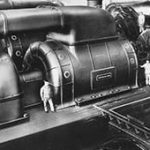100 years of SNV: The Golden Twenties - exuberant, racy and incredibly innovative
To this day, the Roaring Twenties are the epitome of hedonism and joie de vivre. Yet at the beginning of the 1920s, the world was facing a shambles. The First World War (1914-1918) was over, and the 40 or so countries involved in the war had to mourn countless losses, dead and wounded. Nevertheless, another decade in the history of the Swiss Association for Standardization (SNV) begins.

A generation of young men is wiped out or traumatized. Perhaps it is the collective dejection and the feeling that there is nothing left to lose that creates a phenomenal mood of upheaval and change. The 1920s are not only synonymous with fast beats and beguiling trumpet sounds, they are also a decade full of remarkable inventions. The following focus themes are considered here:
Medicine: The discovery of penicillin
In September 1928, Scottish bacteriologist Alexander Fleming accidentally notices in the laboratory that a mold has a growth-inhibiting effect on his forgotten staphylococcus cultures. Further research later leads to the antibiotic penicillin, which will significantly increase human life expectancy. For his discovery, Fleming is awarded the Nobel Prize in 1945, together with Howard Walter Florey and Ernst Boris Chain, who continue his investigations, "for the discovery of penicillin and its curative effect in various infectious diseases".
Standardization does valuable work for laboratory facilities and equipment, which is what makes it possible for instruments and materials to fit together and thus for an efficient process. For example, the introduction of standardized colors and connections for gases has ensured that the anesthesiologist does not confuse nitrous oxide, oxygen and nitrogen.
Physics: Albert Einstein receives the Nobel Prize
Because the young German Albert Einstein wants to study at today's ETH Zurich, he moves to Aarau at the age of 17, where he catches up on his school-leaving exams and then completes his studies with a diploma as a specialist teacher for mathematics and physics. Did he suspect at the time that he would later become the world's best-known scientist of modern times? After various research projects and publications, his path leads him to the patent office in Bern and on to teaching at various universities. In December 1922, Albert Einstein was awarded the Nobel Prize "for his services to theoretical physics, especially for his discovery of the law of the photoelectric effect.
What do innovations have to do with standards?
Standards can serve as a catalyst for innovation and help anchor solutions more quickly in the market. Bringing aspects of an innovation into standardization to prepare the market for it can be crucial to market success. In particular, innovations that span industries and value chains are becoming increasingly significant. Standards bring further advantages:
- Standards as a catalyst for innovation: Standards can serve as a catalyst for innovation and help anchor solutions more quickly in the market. Bringing aspects of an innovation into standardization to prepare the market for it can be crucial to market success. In particular, innovations that reach across industries and value chains are becoming increasingly significant.
- Standards define interfaces and compatibility requirements: In today's networked world, clearly defined interfaces and compatibility between individual components and systems are more important than ever. Cross-border suppliers in particular must ensure that they continue to fit the operational requirements of the companies they supply in the age of Industry 4.0. Those who disregard standards can quickly be excluded from the market.
- Standards facilitate market access: Standards as the global language of technology reduce technical barriers to trade and facilitate the free movement of goods. Standards serve as door openers and promote exports: European standards (EN) open access to the EU internal market, international standards (ISO) to the world market. In Europe today, the principle applies to goods: one standard - one test - accepted everywhere.
- Standards serve to save costs: Standards enable efficiency increases and cost savings across all areas of the company, such as R&D (research and development), design, purchasing, manufacturing, and quality and systems engineering. In addition, standards enable more streamlined and cost-effective production, thus meeting consumers' desire for low-cost performance combined with good quality.
- Standards improve product safety: Standards define quality and minimum requirements and provide recognized solutions for the protection of consumers, health, safety and the environment. Compliance with quality and safety standards can demonstrably reduce the risk of accidents, making a major contribution to protecting the health of consumers and workers.
- Standards reduce the risk of product liability: Standards provide clarity about the properties of a product and are regarded as unambiguous and recognized rules of technology. In contracts, reference to standards provides increased legal certainty. In addition, laws, ordinances and regulations increasingly refer to national, European or international standards in order to adapt them to the state of technical development.
Picture gallery: Those were the 1920s
Sources: Wikipedia, Stern.de, The Board of Trustees of the Science Museum (Penicillin), ABB
100 years of SNV: Anniversary competition
As part of its 100th anniversary, SNV is organizing a competition every month. Answer the competition question and win attractive prizes.
https://www.snv.ch/de/100-jahre-snv/monatswettbewerb.html
















